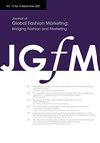New fashion marketing & management in a post-pandemic world
IF 5.5
Q2 BUSINESS
引用次数: 2
Abstract
While every sector has been affected by the COVID-19 pandemic in some way, the fashion industry has experienced extreme hardships, including drastic supply chain disruptions and sharp declines in sales and store traffic (Baum et al., 2020; Chakraborty & Biswas, 2020), leading to a 20% decline in the apparel market’s worldwide revenue between 2019 and 2020 (Amed et al., 2021). The pandemic and the subsequent economic crisis continue to take a toll on the fashion industry. In particular, brick-andmortar fashion businesses, whose struggles were greatly exacerbated by the pandemic, have experienced a high level of retail bankruptcies and a surge in store closures (Ettinger & McDowell, 2021). The crisis heightened uncertainties in people’s lives, shifting consumers’ priorities (they are now less inclined to devote their discretionary spending to clothes) and shopping habits (e.g. contactless payment, curbside pickup, and delivery services) (Knutson, 2021; Thomann, 2020). Fashion companies are now questioning their current business practices and putting effort into adapting to market situations and catering to their consumers’ changing values and behaviors (Liu et al., 2021). This has resulted in inevitable changes in business models to respond to the crisis and prepare for the next normal, thus creating new challenges and new opportunities. However, little information is currently available regarding how fashion businesses can secure business continuity and thrive in the post-COVID-19 world (Zhao & Kim, 2021). In this Special Issue (SI), we have aimed to expand the scope of the relevant multidisciplinary literature to understand what business practices and consumer behaviors will look like post-pandemic and how fashion businesses can thrive by adapting their operations and business strategies to minimize threats and take full advantage of opportunities in the post-COVID-19 world. The focal questions that we have attempted to address in this SI are as follows: How can researchers analyze consumer behaviors and industry practices to provide new insights that can enrich the field? How can marketing practitioners build upon their pandemic experiences and plan their strategies for a postpandemic future?后流行病时代的新时尚营销与管理
虽然每个行业都在某种程度上受到了新冠肺炎疫情的影响,但时尚行业经历了极端的困难,包括供应链的严重中断以及销售额和店铺流量的急剧下降(Baum et al.,2020;Chakraborty&Biswas,2020),导致2019年至2020年间服装市场的全球收入下降了20%(Amed et al.,2021)。疫情和随后的经济危机继续给时尚行业带来损失。特别是,实体时尚企业的困境因疫情而大大加剧,它们经历了高水平的零售破产和店铺关闭激增(Ettinger&McDowell,2021)。这场危机加剧了人们生活中的不确定性,改变了消费者的优先事项(他们现在不太倾向于将可自由支配的支出用于衣服)和购物习惯(例如非接触式支付、路边取货和送货服务)(Knutson,2021;托曼,2020)。时尚公司现在正在质疑他们目前的商业实践,并努力适应市场形势,迎合消费者不断变化的价值观和行为(Liu et al.,2021)。这导致商业模式不可避免地发生变化,以应对危机并为下一个常态做好准备,从而创造了新的挑战和新的机遇。然而,目前几乎没有关于时尚企业如何确保业务连续性并在新冠肺炎疫情后的世界蓬勃发展的信息(赵和金,2021)。在本期特刊(SI)中,我们旨在扩大相关多学科文献的范围,以了解疫情后的商业实践和消费者行为,以及时尚企业如何通过调整运营和商业战略来最大限度地减少威胁并充分利用新冠肺炎后世界的机遇,从而蓬勃发展。我们在本SI中试图解决的焦点问题如下:研究人员如何分析消费者行为和行业实践,以提供丰富该领域的新见解?营销从业者如何在疫情经验的基础上,为疫情后的未来规划战略?
本文章由计算机程序翻译,如有差异,请以英文原文为准。
求助全文
约1分钟内获得全文
求助全文
来源期刊

Journal of Global Fashion Marketing
BUSINESS-
CiteScore
6.90
自引率
31.60%
发文量
34
期刊介绍:
The Journal of Global Fashion Marketing is a quarterly journal that publishes peer-reviewed conceptual and empirical papers and business cases of original works that significantly contribute to the overall advancement of marketing theory, research, and practice in fashion, design, and culture. JGFM endeavors to be a “global bridge” connecting marketing scholars and practitioners in fashion, design, and culture throughout the world. We publish high-quality scholarly articles on marketing written by contributors representing the leading academic authors. As we state on the cover of every issue, our positioning statement, our value added to the marketing scholar readership, is truly to “Bridge Fashion and Marketing” 1. Monitor and analyze global fashion marketing trends. 2. Generate and integrate new ideas and theories related to fashion, luxury, and culture marketing theory and practice. 3. Apply new research methods and techniques in fashion, luxury, and culture marketing. 4. Explore and disseminate cutting edge fashion marketing practices. JGFM welcomes manuscripts that provide fresh, innovative insight to any topic in the field of fashion, luxury, and culture marketing. Both conceptual and empirical works are valued, so long as the manuscript addresses substantive issues in marketing.
 求助内容:
求助内容: 应助结果提醒方式:
应助结果提醒方式:


